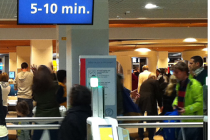Cool IoT Use Cases: Keeping passengers moving in Amsterdam Schiphol Airport

Market overview
![]() The International Air Transport Association (IATA) expects 7.2 billion passengers to travel in 2035, a near doubling of the 3.8 billion figure for 2016. Airports need to be prepared not only for the continuous increase in passenger numbers, but also their demands.
The International Air Transport Association (IATA) expects 7.2 billion passengers to travel in 2035, a near doubling of the 3.8 billion figure for 2016. Airports need to be prepared not only for the continuous increase in passenger numbers, but also their demands.
The problem
![]() Amsterdam Schiphol Airport serves as a transit hub for more than 300 destinations, and passenger numbers have risen from 50 million in 2011 to almost 70 million in 2017. The resulting challenges facing Schiphol include the need to accommodate passengers, avoid safety breaches, comply with changing regulations, keep staff happy, expand capacity and ensure that passengers enjoy a pleasant airport experience.
Amsterdam Schiphol Airport serves as a transit hub for more than 300 destinations, and passenger numbers have risen from 50 million in 2011 to almost 70 million in 2017. The resulting challenges facing Schiphol include the need to accommodate passengers, avoid safety breaches, comply with changing regulations, keep staff happy, expand capacity and ensure that passengers enjoy a pleasant airport experience.
The players
Veovo, a company that markets a Predictive Collaboration Platform specifically designed for airport operations. And the Royal Schiphol Group, whose primary goal is to develop Amsterdam Airport Schiphol into Europe’s preferred airport for passengers, airlines and logistics service providers.
The solution
Eight years ago Schiphol Airport invested in Veovo’s BlipTrack Guest Predictability technology, which enables solutions that improve the way people move through the building by providing real-time queue and movement information.
The partnership continues to play an important role in Schiphol´s predictive approach and digital transformation initiative. The solution covers all terminal entrances to the lounges, but by the end of 2018, it will include the complete passenger journey from airport entrances to gates, and from gates to airport exits.
Inside the airport, the solution provides metrics on passenger queue times and volume, as well as insight into passenger movement patterns throughout the international and domestic terminals departure and arrival processes. The same data benefits passengers by displaying wait times at security checkpoints, managing passenger expectations and reducing queue-related stress.
In addition, a recently developed hybrid camera/Wi-Fi solution helps the airport alleviate critical overcrowding issues, while passenger flow measurement provides a seamless picture of passenger movement and behaviour throughout the airport. It helps the airport add value to the existing facilities and make investments to unlock new business opportunities.
Business benefits
- Continuous airport-wide visibility and measurements
- Detailed analysis of on-going issues
- Faster travel times
- Acceptable wait times
- Less passenger stress
- Real-time reporting
The author is freelance IoT writer, Bob Emmerson
Comment on this article below or via Twitter @IoTGN
